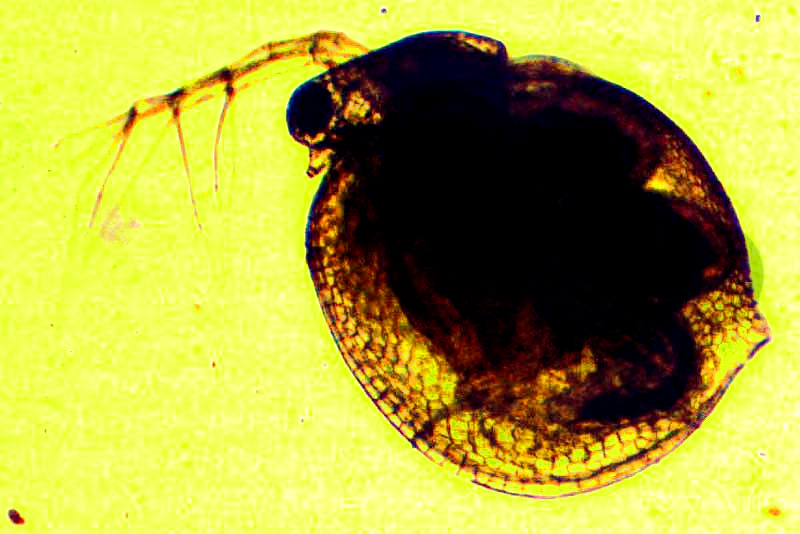Excerpts from Jim Conrad's
Naturalist Newsletter

from the January 20, 2013 Newsletter issued from the valley of the Dry Frio River in northern Uvalde County, southwestern Texas, on the southern border of the Edwards Plateau; elevation ~1750m (~5750 ft); N29.62°, W99.86°; USA
DAPHNIA
A sure sign of spring is that in stagnate pools along the little Dry Frio River behind the cabin pale little specks are appearing jerkily coursing through the clear water. There must be several kinds of organisms involved, but they're fast and hard to suck into the hollow vulture-feather quill I'm using until I can find a pipette or medicine dropper. I did manage to capture one speck, however, which when flushed onto the microscope slide looked a little smaller than a grain of salt. That's what she looked like under high magnification above.
That's one of the commonest, best known and easily recognizable of microscopic animals likely to be found in natural bodies of water nearly worldwide. Often it's called a water flea, but some folks call any tiny, erratically moving thing in water by that name. A more informative name is Daphnia, which is the genus name. About 150 species of Daphnia are recognized, living in very many habitats, not only freshwater ones but also very acidic and saline ones. I can't say which species ours is. I think ours had a sharp tail that broke off.
Our Daphnia was unhappy to be on a microscope slide and tried to swim away by beating its antler-like appendages like oars. The dark spot in the head area looking like eyes are indeed compound eyes, like those of an insect. Inside the transparent body, note the dark, baglike area almost touching the back, just above the broken-off tail. That dark area is the brood pouch.
In the spring normally only female Daphnia are encountered. Without the benefit of sex these females parthenogenetically give birth to other females, who similarly will give sexless birth only to more females. These repeating generations of females will continue until cold weather returns or other harsh conditions develop, when males will appear, sex take place, and eggs for the next generation will be produced.
From the moment it emerges from its egg it takes a Daphnia about two weeks to reach adulthood. Under ideal conditions a mature female can produce a new brood about every ten days so, doing the math, it's clear that the life expectancy of a Daphnia is not great, else we'd be knee deep in Daphnia. Lots of small aquatic animals eat Daphnias. In fact, Daphnias are such excellent fare that among aquarists the most popular live food for aquarium fishes is Daphnia. Daphnia themselves eat algae, bacteria, decaying organic matter and such.
Daphnia are crustaceans, along with crabs, lobsters, crayfish, shrimp and barnacles. All crustaceans are encased in exoskeletons, from which they must periodically molt in order to grow.